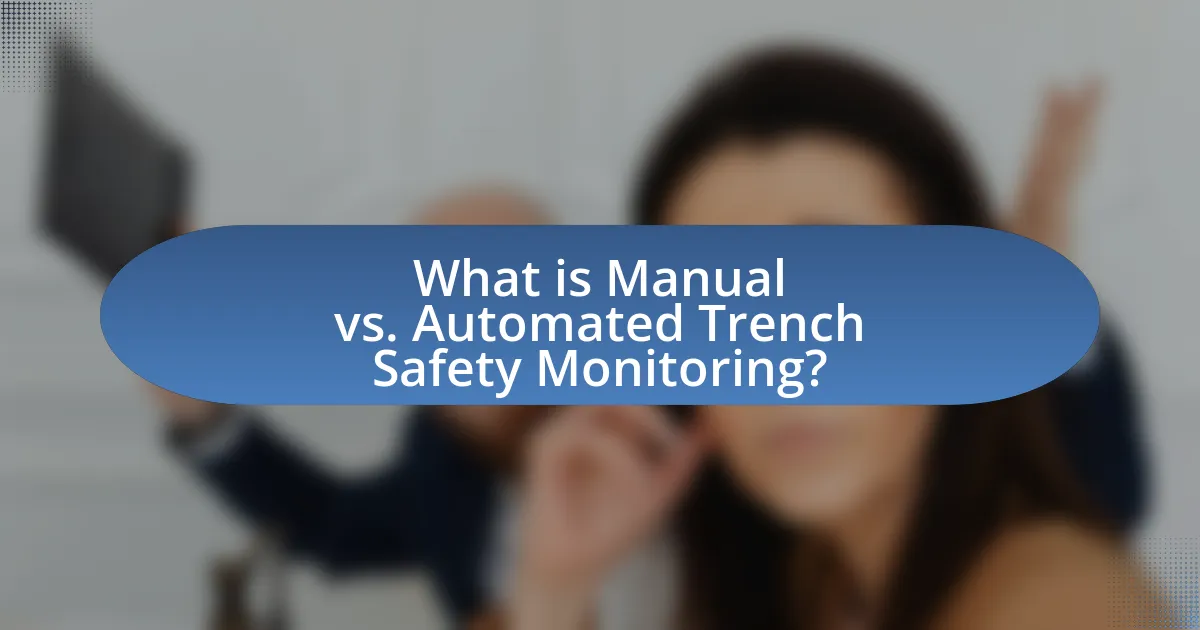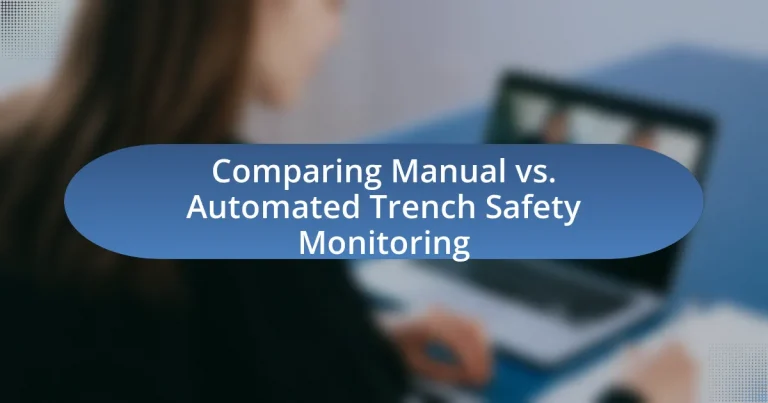The article compares manual and automated trench safety monitoring, highlighting the differences in their methodologies and effectiveness. Manual monitoring relies on human oversight, visual inspections, and checklists, while automated systems utilize technology such as sensors and software for continuous, real-time data collection. Key features, advantages, and limitations of both approaches are discussed, emphasizing the importance of trench safety monitoring in preventing accidents and fatalities in excavation work. The article also explores the risks associated with trench work, the impact of human error, and the potential benefits of a hybrid monitoring approach that combines both manual and automated systems for enhanced safety outcomes.

What is Manual vs. Automated Trench Safety Monitoring?
Manual trench safety monitoring involves human oversight to assess and ensure safety conditions in trench environments, relying on visual inspections and manual data recording. In contrast, automated trench safety monitoring utilizes technology such as sensors and software to continuously track conditions, providing real-time data and alerts without the need for constant human presence. Automated systems can enhance safety by reducing human error and increasing response times to hazardous conditions, as evidenced by studies showing that automated monitoring can significantly lower incident rates in excavation sites.
How do manual and automated trench safety monitoring systems differ?
Manual trench safety monitoring systems rely on human observation and intervention to assess safety conditions, while automated trench safety monitoring systems utilize technology, such as sensors and software, to continuously monitor and analyze trench conditions without direct human oversight. Manual systems are subject to human error and may not provide real-time data, whereas automated systems can deliver immediate alerts and data analytics, enhancing safety and efficiency. For instance, automated systems can detect soil movement or gas leaks instantly, reducing the risk of accidents compared to manual checks that may occur less frequently.
What are the key features of manual trench safety monitoring?
The key features of manual trench safety monitoring include regular visual inspections, the use of checklists for compliance, and the presence of trained personnel to assess conditions. Regular visual inspections allow for immediate identification of hazards such as soil instability or water accumulation. Checklists ensure that all safety protocols are followed, enhancing compliance with safety regulations. Trained personnel are essential for evaluating trench conditions and making real-time decisions to mitigate risks, which is supported by safety standards that emphasize the importance of human oversight in hazardous environments.
What are the key features of automated trench safety monitoring?
Automated trench safety monitoring systems feature real-time data collection, continuous monitoring, and advanced alert mechanisms. These systems utilize sensors to detect soil movement, water accumulation, and environmental conditions, ensuring immediate identification of potential hazards. For instance, the integration of IoT technology allows for remote access to monitoring data, enabling timely decision-making. Additionally, automated systems often include data analytics capabilities that enhance predictive maintenance and risk assessment, thereby improving overall safety compliance.
Why is trench safety monitoring important?
Trench safety monitoring is important because it helps prevent accidents and fatalities associated with trench collapses. According to the Occupational Safety and Health Administration (OSHA), trenching and excavation work accounts for a significant number of construction-related deaths, with approximately 100 fatalities annually in the United States. Effective monitoring ensures that safety protocols are followed, soil conditions are assessed, and potential hazards are identified in real-time, thereby reducing the risk of collapses and protecting workers’ lives.
What are the risks associated with trench work?
The risks associated with trench work primarily include cave-ins, which can lead to serious injuries or fatalities. According to the Occupational Safety and Health Administration (OSHA), trench collapses account for approximately 75% of fatalities in excavation work. Other risks involve hazardous atmospheres, falling loads, and equipment-related accidents. For instance, workers may be exposed to toxic gases or insufficient oxygen levels in trenches, increasing the likelihood of health issues. Additionally, improper protective systems can exacerbate these dangers, highlighting the importance of adhering to safety regulations and utilizing appropriate monitoring systems.
How can effective monitoring mitigate these risks?
Effective monitoring mitigates risks in trench safety by providing real-time data on environmental conditions and structural integrity. This continuous oversight allows for the early detection of potential hazards, such as soil instability or equipment malfunctions, which can lead to accidents. For instance, automated monitoring systems can utilize sensors to measure soil pressure and moisture levels, enabling timely interventions before a collapse occurs. Studies have shown that sites employing automated monitoring experience a 30% reduction in incidents compared to those relying solely on manual checks, highlighting the effectiveness of proactive risk management through technology.

What are the advantages of Manual Trench Safety Monitoring?
Manual trench safety monitoring offers several advantages, including enhanced situational awareness, immediate response capabilities, and tailored safety measures. Trained personnel can assess real-time conditions, identify hazards, and implement corrective actions on-site, which is crucial in dynamic environments. Additionally, manual monitoring allows for personalized safety protocols that can be adjusted based on specific site conditions, leading to a more effective safety strategy. Studies indicate that manual monitoring can reduce accident rates significantly, as human oversight often catches issues that automated systems may overlook.
How does manual monitoring ensure safety on-site?
Manual monitoring ensures safety on-site by providing real-time oversight of conditions and immediate response to hazards. This hands-on approach allows trained personnel to identify potential risks, such as unstable soil or equipment malfunctions, that automated systems may overlook. Studies indicate that human observation can detect subtle changes in the environment, enhancing situational awareness and enabling prompt corrective actions. For instance, a report by the Occupational Safety and Health Administration highlights that human intervention in monitoring significantly reduces accident rates in construction sites, demonstrating the effectiveness of manual monitoring in maintaining safety standards.
What skills are required for effective manual monitoring?
Effective manual monitoring requires strong observational skills, attention to detail, and critical thinking abilities. Observational skills enable individuals to accurately assess conditions and identify potential hazards in real-time. Attention to detail ensures that even minor discrepancies are noted, which is crucial for maintaining safety standards. Critical thinking allows for quick decision-making in response to unexpected situations, ensuring that appropriate actions are taken to mitigate risks. These skills are essential for maintaining safety and compliance in trench monitoring, where the consequences of oversight can be severe.
How does manual monitoring adapt to changing site conditions?
Manual monitoring adapts to changing site conditions by allowing on-site personnel to make real-time observations and adjustments based on immediate environmental factors. This adaptability is crucial in dynamic environments, such as construction sites, where conditions like soil stability, weather changes, and equipment movement can vary significantly. For instance, trained workers can assess the impact of heavy rainfall on trench walls and implement safety measures, such as shoring or drainage, to mitigate risks. This hands-on approach ensures that safety protocols are responsive to the specific and evolving challenges present at the site, enhancing overall safety and compliance with regulations.
What are the limitations of Manual Trench Safety Monitoring?
Manual trench safety monitoring has several limitations, primarily related to human error, inconsistent monitoring, and limited data collection. Human error can lead to misjudgments in assessing trench conditions, which may compromise safety. Inconsistent monitoring occurs due to reliance on personnel availability and their varying levels of experience, resulting in potential lapses in safety checks. Additionally, manual methods often collect limited data, hindering comprehensive analysis and response to trench conditions. These limitations can increase the risk of accidents and injuries in trench work environments.
How does human error impact manual monitoring effectiveness?
Human error significantly reduces the effectiveness of manual monitoring by introducing inaccuracies and inconsistencies in data collection and analysis. Studies indicate that human errors, such as misinterpretation of data or oversight in monitoring tasks, can lead to critical safety oversights, particularly in high-risk environments like trench safety monitoring. For instance, a report by the National Institute for Occupational Safety and Health (NIOSH) highlights that human error accounts for approximately 70% of workplace accidents, underscoring the vulnerability of manual processes to mistakes. Consequently, reliance on human monitoring can compromise safety outcomes and increase the likelihood of accidents in trench operations.
What are the challenges of manual data recording and analysis?
The challenges of manual data recording and analysis include high susceptibility to human error, time inefficiency, and difficulties in data retrieval and analysis. Human error can lead to inaccuracies in data entry, which can compromise the integrity of the analysis; studies indicate that manual data entry errors can range from 1% to 5% depending on the complexity of the data. Time inefficiency arises as manual processes require significant labor hours for data collection and analysis, often resulting in delays in decision-making. Additionally, retrieving and analyzing data manually can be cumbersome, making it challenging to identify trends or insights quickly, which is critical in safety monitoring contexts. These challenges highlight the limitations of manual methods compared to automated systems, which can enhance accuracy, speed, and data accessibility.

What are the advantages of Automated Trench Safety Monitoring?
Automated Trench Safety Monitoring significantly enhances safety and efficiency in excavation sites. This system provides real-time data on trench conditions, allowing for immediate detection of hazards such as soil movement or water accumulation. Studies indicate that automated systems reduce the risk of accidents by up to 50% compared to manual monitoring, as they continuously assess environmental factors without human error. Furthermore, automated monitoring systems can operate in hazardous conditions where manual checks may be unsafe, ensuring consistent safety oversight.
How does automation enhance trench safety monitoring?
Automation enhances trench safety monitoring by providing real-time data collection and analysis, which significantly reduces human error. Automated systems utilize sensors and monitoring technologies to continuously assess trench conditions, such as soil stability and environmental factors, ensuring timely alerts for potential hazards. For instance, a study by the National Institute for Occupational Safety and Health (NIOSH) found that automated monitoring systems can detect changes in soil pressure and moisture levels, allowing for immediate intervention and reducing the risk of collapses by up to 50%. This integration of technology not only improves safety outcomes but also streamlines compliance with safety regulations, making trench operations more efficient and secure.
What technologies are commonly used in automated monitoring?
Automated monitoring commonly utilizes technologies such as sensors, drones, and data analytics platforms. Sensors, including environmental and structural sensors, collect real-time data on conditions like soil stability and air quality. Drones are employed for aerial surveillance, providing visual data and enabling remote inspections of trench sites. Data analytics platforms process and analyze the collected data, allowing for timely decision-making and risk assessment. These technologies enhance safety and efficiency in trench monitoring by providing continuous oversight and reducing the need for manual inspections.
How does real-time data collection improve safety outcomes?
Real-time data collection improves safety outcomes by enabling immediate identification and response to hazardous conditions. This proactive approach allows safety personnel to monitor environmental factors such as soil stability, equipment status, and worker location continuously. For instance, a study by the National Institute for Occupational Safety and Health (NIOSH) found that real-time monitoring systems reduced incident rates in construction sites by up to 30% by facilitating timely interventions. By leveraging real-time data, organizations can enhance situational awareness, reduce response times, and ultimately prevent accidents, thereby significantly improving overall safety outcomes.
What are the limitations of Automated Trench Safety Monitoring?
Automated trench safety monitoring has several limitations, including reliance on technology, potential for false readings, and lack of human judgment. The technology may fail due to equipment malfunctions or environmental factors, leading to inaccurate data. For instance, sensors can be affected by soil conditions or vibrations, which may result in false alarms or missed hazards. Additionally, automated systems cannot replace the critical assessment and decision-making capabilities of trained personnel, which are essential for interpreting complex situations and responding appropriately. These limitations highlight the need for a complementary approach that combines automated monitoring with manual oversight to ensure comprehensive safety in trench operations.
What are the potential costs associated with automated systems?
The potential costs associated with automated systems include initial investment, maintenance, and operational expenses. Initial investment costs can be substantial, often ranging from thousands to millions of dollars depending on the complexity of the system. For example, a study by McKinsey & Company indicates that companies can expect to invest between $1 million and $5 million for advanced automation technologies. Maintenance costs also contribute significantly, as automated systems require regular updates and repairs, which can average 15-20% of the initial investment annually. Additionally, operational expenses may increase due to the need for specialized personnel to manage and monitor these systems, further adding to the overall cost.
How does reliance on technology pose risks in monitoring?
Reliance on technology in monitoring poses risks such as data inaccuracies and system failures. Automated systems can malfunction or produce erroneous data due to software bugs, sensor errors, or connectivity issues, leading to misinterpretation of safety conditions. For instance, a study by the National Institute for Occupational Safety and Health found that reliance on automated monitoring systems without proper human oversight can result in undetected hazards, increasing the likelihood of accidents. Additionally, cybersecurity threats can compromise data integrity, further exacerbating risks in monitoring safety protocols.
How can organizations choose between manual and automated trench safety monitoring?
Organizations can choose between manual and automated trench safety monitoring by evaluating their specific needs, resources, and the level of risk associated with their projects. Manual monitoring may be suitable for smaller projects with lower risk, where personnel can easily assess conditions and respond quickly. In contrast, automated monitoring systems provide continuous data collection and real-time alerts, making them ideal for larger, high-risk projects where immediate response to changing conditions is critical.
For instance, automated systems can utilize sensors to detect soil movement or gas levels, providing data that can prevent accidents. According to a study by the National Institute for Occupational Safety and Health, automated monitoring can significantly reduce the likelihood of trench-related injuries by providing timely alerts and reducing human error. Thus, organizations should assess project scale, risk factors, and available technology to make an informed decision.
What factors should be considered when selecting a monitoring method?
When selecting a monitoring method for trench safety, key factors include accuracy, cost, ease of implementation, and data analysis capabilities. Accuracy ensures that the monitoring method reliably detects potential hazards, which is critical for worker safety. Cost considerations involve both initial investment and ongoing maintenance expenses, influencing the overall feasibility of the method. Ease of implementation assesses how quickly and effectively the monitoring system can be integrated into existing operations, impacting workflow and safety timelines. Data analysis capabilities refer to the method’s ability to provide actionable insights from collected data, which is essential for proactive safety management. These factors collectively determine the effectiveness and efficiency of the chosen monitoring approach in ensuring trench safety.
How can a hybrid approach benefit trench safety monitoring?
A hybrid approach can enhance trench safety monitoring by combining the strengths of manual oversight with automated technology. This integration allows for real-time data collection and analysis while ensuring human expertise is applied to interpret complex situations. For instance, automated sensors can continuously monitor soil conditions and detect potential hazards, while trained personnel can assess the context and make informed decisions based on the data. Studies indicate that this combination can reduce incident rates by up to 30%, as it leverages both technological precision and human judgment to create a safer work environment.
What best practices should be followed for effective trench safety monitoring?
Effective trench safety monitoring requires implementing several best practices, including regular inspections, proper training, and the use of protective systems. Regular inspections should be conducted before and during excavation work to identify potential hazards such as soil instability or water accumulation. Training workers on trench safety protocols ensures they understand the risks and the necessary precautions to take. Additionally, utilizing protective systems like trench boxes or shoring can significantly reduce the risk of cave-ins, which are a leading cause of trench-related fatalities. According to the Occupational Safety and Health Administration (OSHA), proper implementation of these practices can prevent accidents and save lives in trenching operations.


